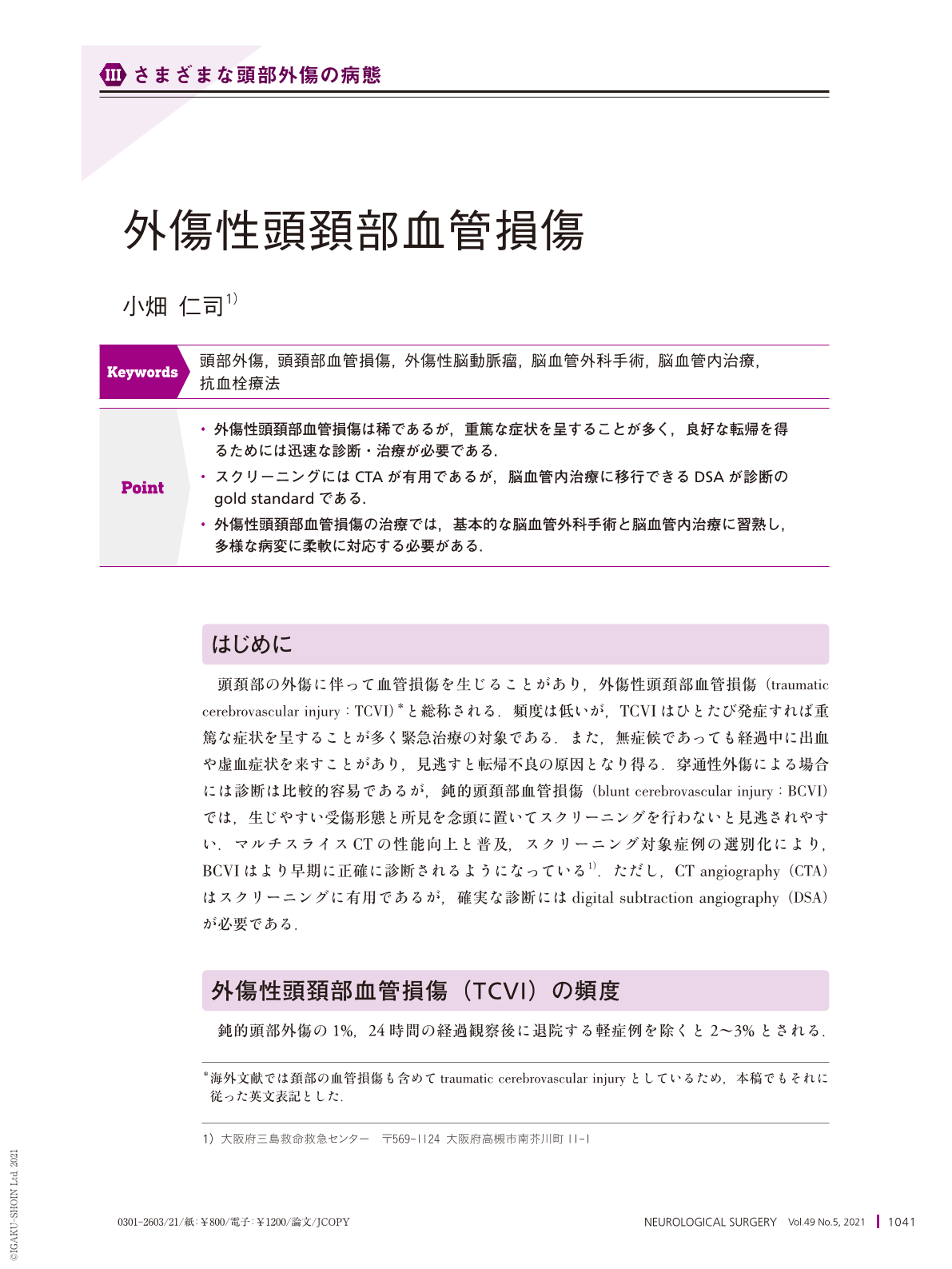- 著者
- 小畑 仁 細野 篤子 妹尾 啓史 田中 晶善
- 出版者
- 一般社団法人 日本土壌肥料学会
- 雑誌
- 日本土壌肥料学会講演要旨集 (ISSN:02885840)
- 巻号頁・発行日
- vol.47, 2001
2 0 0 0 外傷性頭頚部血管損傷
- 著者
- 小畑 仁司 荻田 誠司 川上 真樹子 二村 元 杉江 亮
- 出版者
- 一般社団法人 日本脳卒中の外科学会
- 雑誌
- 脳卒中の外科 (ISSN:09145508)
- 巻号頁・発行日
- vol.45, no.6, pp.445-450, 2017 (Released:2017-12-22)
- 参考文献数
- 23
- 被引用文献数
- 2 1
Fever in subarachnoid hemorrhage (SAH) is associated with vasospasm and poor outcome. To mitigate early brain damage in SAH, we have been treating World Federation of Neurological Surgeons (WFNS) Grade 5 patients with rapid induction of therapeutic hypothermia (TH) initiated immediately following onset of SAH and continued for approximately 7 days. Management after rewarming has been problematic. Rebound fever, especially during the period of post-SAH vasospasm, may increase the risk of cerebral infarction. We prospectively studied the feasibility and safety of endovascular cooling for maintaining prophylactic normothermia following initial TH in patients with severe SAH.TH (core body temperature 34.0°C) using surface cooling was initiated immediately after a diagnosis of WFNS Grade 5 SAH was made. All ruptured aneurysms were surgically clipped as soon as possible within 6 hours after arrival. At approximately postoperative day 7, after rewarming to 36°C, an endo- vascular catheter with 2 cooling balloons (Cool Line® Catheter, Asahi Kasei ZOLL Medical Corp., Tokyo, Japan) was inserted into the left internal jugular vein and connected to the Thermogard XP® Temperature Management System (Asahi Kasei ZOLL Medical Corp.) for the following 7 days. Temperature recordings in 11 SAH patients immediately before the period of endovascular cooling served as the control.Eleven patients (6 women; mean age of 63.8 ± 6.4 years [range, 50-73 years]) were enrolled in the study. Endovascular cooling was initiated at 7.9 ± 1.4 days (range, 6-11 days) after admission and continued for 6.7 ± 0.9 days (range 4-7 days). Unfavorable outcomes were associated with minimal shivering and good temperature control, whereas favorable outcomes were associated with vigorous shivering and increased temperature. Nine patients manifested shivering with increased temperature and were treated with acetaminophen, dexmedetomidine, and/or propofol. During the study period, two patients developed fevers above 38°C, and 8 of 11 patients without endovascular cooling developed fevers (p=0.03, two-tailed Fisher's exact test). There was no evidence of cerebral infarction related to vasospasm during endovascular cooling, and no catheter-related sepsis or thromboembolic events. In one patient, fasudil hydrochloride was administered intra-arterially for angiographic vasospasm, resulting in no cerebral infarction. In another patient, intensive treatment was withdrawn because of massive brain swelling; however, slight but extensive early ischemic change was retrospectively confirmed on computed tomography prior to endovascular cooling. Vasospasm-related cerebral infarction occurred in one patient 2 days after removal of the cooling catheter. In one patient, fatal bacterial meningitis related to spinal drainage occurred on Day 29. Three-month outcomes showed good recovery in 2, moderate disability in 4, severe disability in 2, vegetative state in 1, and death in 2. Amelioration of fever burden during the first 14 days after onset of SAH was safe and feasible with combined surface and endovascular cooling in patients with WFNS Grade 5 SAH.
1 0 0 0 カルボキシペプチダーゼのカディスチン[(γ-EC)nG]合成能
- 著者
- 土坂 享成 木村 哲哉 今井 邦雄 妹尾 啓史 田中 晶善 小畑 仁
- 出版者
- 社団法人 環境科学会
- 雑誌
- 環境科学会誌 = Environmental science (ISSN:09150048)
- 巻号頁・発行日
- vol.12, no.4, pp.393-398, 1999-11-30
- 参考文献数
- 14
- 被引用文献数
- 1
前報において,カドミウム解毒に重要な役割を果たすと考えられている(γ-EC)<SUB>n</SUB>G合成酵素の性質について,水稲根を用いて検討したことを報告し,水稲根中で(γ-EC)<SUB>n</SUB>Gを合成している酵素の少なくとも一部がカルボキシペプチダーゼである可能性を示唆した。これを踏まえ,本研究では各種のカルボキシペプチダーゼに(γ-EC)<SUB>n</SUB>Gの合成能力があるかを検討した。更に,イネ由来のカルボキシペプチダーゼ遺伝子を発現ベクターに組み込み,これを大腸菌に導入してカルボキシペプチダーゼ遺伝子を発現させ,それにより(γ-EC)<SUB>n</SUB>G合成能力が増大するかを検討した。 その結果,全てのカルボキシペプチダーゼ標品において(γ-EC)<SUB>n</SUB>Gの合成が認められ,その至適pHはカルボキシペプチダーゼの分解活性のそれとほぼ同じであった。また,その合成活性はカルボキシペプチダーゼの特異的阻害剤により抑制されることが認められた。比較のために行ったアミノペプチダーゼ標品では(γ-EC)<SUB>n</SUB>Gの合成は認められなかった。一方,カルボキシペプチダーゼ遺伝子を導入した大腸菌の抽出液における(γ-EC)<SUB>n</SUB>G合成活性が,導入していない方よりも増大したことが認められた。これらのことから,カルボキシペプチダーゼが(γ-EC)nGを合成している酵素の一つである可能性が更に強く示唆された。
- 著者
- 山下 佳伸 水野 隆文 藤嶽 明日香 小畑 仁
- 出版者
- 一般社団法人 日本土壌肥料学会
- 雑誌
- 日本土壌肥料学会講演要旨集 50 (ISSN:02885840)
- 巻号頁・発行日
- pp.110, 2004-09-14 (Released:2017-06-27)
1 0 0 0 OA 多発感染病巣を合併したクレブシエラ肝膿傷の1例
- 著者
- 橘高 弘忠 西本 昌義 福田 真樹子 西原 功 小畑 仁司 大石 泰男 秋元 寛
- 出版者
- 一般社団法人 日本救急医学会
- 雑誌
- 日本救急医学会雑誌 (ISSN:0915924X)
- 巻号頁・発行日
- vol.24, no.7, pp.406-412, 2013-07-15 (Released:2013-10-16)
- 参考文献数
- 11
- 被引用文献数
- 1
症例は61歳の男性。3年前にKlebsiella pneumoniaeを起因菌とした肝膿瘍の既往があった。発熱と全身倦怠感を主訴に他院に救急搬送され,精査の結果,肝膿瘍による敗血症,播種性血管内凝固症候群と診断され当センターへ転院となった。腹部超音波検査,腹部造影CT検査所見では,肝外側区域に隔壁を伴う膿瘍形成を認め,抗菌薬(BIPM)の投与を開始した。第2病日に呼吸状態が悪化したため,気管挿管し人工呼吸器管理を開始するとともに超音波ガイド下経皮経肝的膿瘍ドレナージ術を行った。ドレーン造影を行うと,蜂巣状の膿瘍とそれに連続して胆管が造影された。穿刺液細菌培養の結果,Klebsiella pneumoniaeが検出された。発熱が続いたため,第10病日に腹部CTを撮影したところ,肝膿瘍の増大,右腸腰筋膿瘍およびL3/L4の化膿性脊椎炎の合併を認めた。また第11病日より項部硬直が出現した。髄膜炎を疑い,髄液採取を試みたものの採取できなかったため,頭部MRIを行ったが異常所見はなかった。肝膿瘍に対してドレナージ治療の限界と判断し,第12病日に肝外側区域切除術を施行したが,発熱・意識障害は遷延した。第18病日に髄液採取に成功し,細菌培養検査を施行したところ,多剤耐性のEnterococcus faeciumが検出された。Linezolidの追加投与を開始したところ,解熱とともに意識レベルは改善し,第30病日のCTでは腸腰筋膿瘍と脊椎炎の消失を認めた。意識レベルの改善とともに視力障害の訴えがあったため,眼科へコンサルトしたところ細菌性眼内炎と診断され転院となった。本症例は肝膿瘍から転移性病変を生じ,さらに菌交代を伴ったためEnterococcus faeciumが起因菌となったものと考えた。

